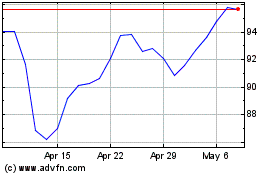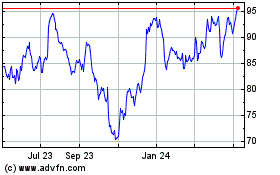Morgan Stanley's Brokers Hit $1 Million Revenue Milestone, Pass Merrill's
January 17 2017 - 1:39PM
Dow Jones News
By Michael Wursthorn
Morgan Stanley's brokers hit a productivity milestone -- more
than $1 million in average revenue per broker -- and put themselves
ahead of rival Merrill Lynch for the first time.
In an analyst call to discuss the bank's fourth-quarter results,
Morgan Stanley said its brokers on average generated $1.01 million
in annual revenue during the period, up from $947,000 the year
before. The fourth-quarter total represents a 46% gain since 2009,
when Morgan Stanley combined its wealth unit with Citigroup Inc.'s
Smith Barney brokerage.
Bank of America Corp.'s Merrill Lynch, in comparison, last week
said its brokers generated average revenue of $964,000 in the
fourth quarter.
The biggest retail brokerages have lusted after the $1
million-per-broker threshold in the years since the financial
crisis, as firms have put more emphasis on raising the average
revenue generated per broker and less on fielding bigger broker
forces.
UBS Group AG's U.S. brokerage was the first to surpass the $1
million average revenue mark in 2012 with a broker force less than
half the size of Morgan Stanley's. Merrill Lynch hit the $1 million
threshold in 2013, but they haven't hit it again since mid-2015 as
lower revenue and an influx of newer brokers have pulled that
average down.
Morgan Stanley's brokers helped push the unit's revenue, profit
and assets higher. The wealth unit's fourth-quarter profit rose 16%
to $891 million from the year-earlier quarter on revenue of $3.99
billion, which was up 6%. Client assets ticked up 6% to $2.1
trillion thanks to inflows and higher market valuations. The firm
continued to build up its banking operations, collecting $153
billion in deposits, up 3% from last year, and $73 billion in
liabilities, which was 14% higher than 2015.
Morgan Stanley's wealth arm had a pretax profit margin of 22%,
down 1 percentage point from the third quarter, but up 2 points
from the year-earlier quarter.
Morgan Stanley as a whole posted its best fourth quarter since
the financial crisis.
The bank's brokerage gains came as the firm continued to invest
in new digital wealth-management tools and services for its clients
amid a reduction of its head count and footprint. Morgan Stanley's
number of brokerage branches was 601 as of the end of 2016, down
about one-third since 2009, while the number of brokers has fallen
13% over that time to 15,763.
Morgan Stanley's branch closures have been part of its
consolidation efforts following the Smith Barney merger, a
spokesman said, adding that the firm hasn't withdrawn from any
markets. "As leases have come up for renegotiation, we have
consolidated office locations in markets where there was
duplication," the spokesman said.
The spokesman also said Morgan Stanley's digital investments
won't affect its number of branches.
Morgan Stanley Chief Executive James Gorman offered additional
color regarding the bank's digital strategy Tuesday, saying the
investments should modernize its branches so clients can be served
more efficiently, while offering investors the chance to interact
with the firm on a purely digital basis.
"Over time, we want digital capabilities to service individuals
who are more focused on a full digital relationship," Mr. Gorman
said. He added that while the firm continues to focus on working
with ultrawealthy clients, it is open to using its digital tools to
work with clients with less in assets.
Write to Michael Wursthorn at Michael.Wursthorn@wsj.com
(END) Dow Jones Newswires
January 17, 2017 13:24 ET (18:24 GMT)
Copyright (c) 2017 Dow Jones & Company, Inc.
Morgan Stanley (NYSE:MS)
Historical Stock Chart
From Mar 2024 to Apr 2024

Morgan Stanley (NYSE:MS)
Historical Stock Chart
From Apr 2023 to Apr 2024
